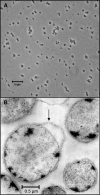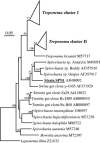Spirochaeta coccoides sp. nov., a novel coccoid spirochete from the hindgut of the termite Neotermes castaneus
- PMID: 16391069
- PMCID: PMC1352290
- DOI: 10.1128/AEM.72.1.392-397.2006
Spirochaeta coccoides sp. nov., a novel coccoid spirochete from the hindgut of the termite Neotermes castaneus
Abstract
A novel spirochete strain, SPN1, was isolated from the hindgut contents of the termite Neotermes castaneus. The highest similarities (about 90%) of the strain SPN1 16S rRNA gene sequence are with spirochetes belonging to the genus Spirochaeta, and thus, the isolate could not be assigned to the so-called termite clusters of the treponemes or to a known species of the genus Spirochaeta. Therefore, it represents a novel species, which was named Spirochaeta coccoides. In contrast to all other known validly described spirochete species, strain SPN1 shows a coccoid morphology and is immotile. The isolated strain is obligately anaerobic and ferments different mono-, di-, and oligosaccharides by forming formate, acetate, and ethanol as the main fermentation end products. Furthermore, strain SPN1 is able to grow anaerobically with yeast extract as the sole carbon and energy source. The fastest growth was obtained at 30 degrees C, the temperature at which the termites were also grown. The cells possess different enzymatic activities that are involved in the degradation of lignocellulose in the termite hindgut, such as beta-D-glucosidase, alpha-L-arabinosidase, and beta-D-xylosidase. Therefore, they may play an important role in the digestion of breakdown products from cellulose and hemicellulose in the termite gut.
Figures


References
-
- Berchtold, M., A. Chatzinotas, W. Schönhuber, A. Brune, R. Amann, D. Hahn, and H. König. 1999. Differential enumeration and in situ localisation of microorganisms in the hindgut of the lower termite Mastotermes darwiniensis. Arch. Microbiol. 172:407-416. - PubMed
-
- Berchtold, M., and H. König. 1996. Phylogenetic analysis and in situ identification of uncultivated spirochetes from the hindgut of the termite Mastotermes darwiniensis. Syst. Appl. Microbiol. 19:66-73.
-
- Berchtold, M., W. Ludwig, and H. König. 1994. 16S rDNA sequence and phylogenetic position of an uncultivated spirochete from the hindgut of the termite Mastotermes darwiniensis Froggatt. FEMS Microbiol. Lett. 123:269-273. - PubMed
-
- Bignell, D. E., and J. M. Anderson. 1980. Determination of pH and oxygen status in the guts of lower and higher termites. J. Insect Physiol. 26:183-188.
-
- Breznak, J. A. 1984. Hindgut spirochetes of termites and Cryptocercus puntulatus, p. 67-70. In N. R. Krieg and J. G. Holt (ed.), Bergey's manual of systematic bacteriology, vol. 1. Williams & Wilkins, Baltimore, Md.
MeSH terms
Substances
LinkOut - more resources
Full Text Sources
Molecular Biology Databases

